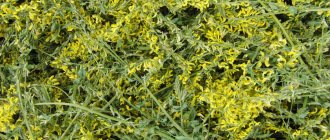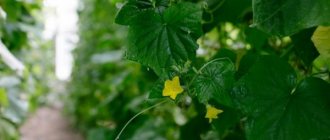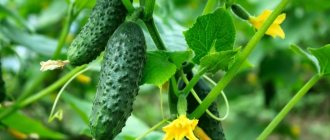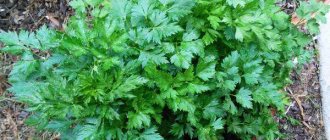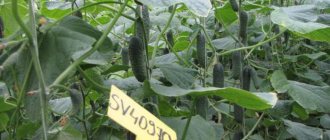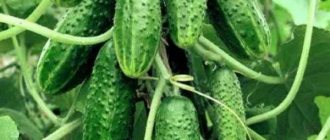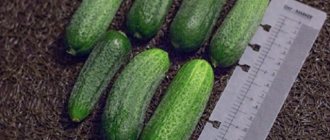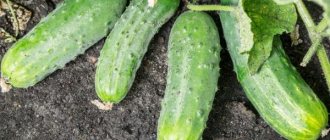If cucumbers do not have enough potassium, what should they feed them with?
Potassium fertilizers for cucumbers are divided into organic and mineral.
The name of the most widely used fertilizer is potassium sulfate. It is produced from the mineral shepite, it dissolves well in the earth. In appearance they are small white granules. You can make a solution from fertilizer or scatter it and dig up the soil.
Potassium sulfate for cucumbers is fed to the soil:
- peat;
- lime;
- sand;
- loam;
- black soil
It is not recommended to use potassium sulfate on solonetzes, because they already have enough natural mineral fertilizers.
Attention! If the soil has acidic characteristics, then lime must be added along with potassium sulfate. But first they scatter lime, and after 2 weeks potassium.
Potassium sulfate is applied in autumn, spring, and when plants are flowering. When the buds open, fertilizer is applied to the foliage.
Experienced gardeners do this:
- in the fall, sprinkle potassium on heavy clay soil and dig up the soil;
- and in the spring they add potassium if the soil is light - sandy or sandy loam;
- in autumn and spring, if the soil is peaty;
- spray the crop on the foliage with a solution of potassium.
In the fall, scatter 30 g of potassium sulfate per 1 m² and dig up the soil to the depth of a shovel. After showers and snow, the fertilizer will dissolve.
In the spring, the required amount of potassium is poured into a hole in which the seedlings are planted and watered abundantly.
Fertilizers should be applied depending on the type of land. You also need to carefully consider the landings:
- what color is the foliage?
- number of flowers;
- whether the ovaries have begun to appear;
- What shape is the green grass - regular or deformed?
Root
Root feeding is carried out with a diluted composition or dry granules of potassium sulfate. To prepare the solution, you need to take 10 liters of water (a bucket) and add 2-3 tablespoons of granules, stir and water the bushes. Watering results in faster results on lighter soils.
Foliar
It is necessary to dilute 1.5-2 tbsp. spoons of potassium sulfate in a bucket of clean water
If the soil is heavy loamy, then it is better to spray the crop with potassium solution on the leaves. To do this, you need to dilute 1.5-2 tbsp. spoons of potassium sulfate in a bucket of clean water. You should spray the bushes very early in the morning or in the evening, when the sun has already set, then the leaves will not be burned. It is better to do this on a day without rain.
The benefits of potassium fertilizers for cucumbers
Compositions with potassium improve the characteristics of the plant and the taste of the fruit:
- Fertilizer improves immunity, protects against pest attacks, and reduces the likelihood of contracting infections.
- Normalizes metabolic processes in the plant, resulting in increased resistance to drought and frost.
- Promotes active flowering and full fruit formation.
- The shelf life of the harvested crop is increasing.
In order for the plant to develop successfully, the component must be sufficient for the entire growing season.
Signs of potassium deficiency in cucumbers
Since the element is involved in the metabolic processes of plants, its deficiency is reflected in their external condition. There are several signs of potassium deficiency:
- intensive development of vegetative mass with sparse flowering;
- multiple barren flowers and lack of ovary in the future;
- change in foliage color to dark green;
- curvature of the fruit - hook-shaped, as in the photo.
When cucumbers lack potassium in large quantities, the green mass also begins to suffer: the “symptoms” are obvious. With an acute deficiency, the edges of the leaves acquire a gray-yellow color, and the edge gradually dries out. Necrotic lesions are noted up to the middle of the leaf blade, then the latter dies. Due to a metabolic disorder, the ovary developing at this time lacks sugar, its delivery to the fruit stops - the greens become bitter.
Types of fertilizers
Potash fertilizers are divided into two large groups: mixtures containing chlorine and sulfate fertilizers, which are produced in the form of small granules.
Potassium humate
The fertilizer contains a lot of humic acids and other useful components. Can be purchased in liquid and dry form.
Fertilizing has the following beneficial effects on the plant:
- soil composition improves;
- the process of fruit formation accelerates, the number of nitrates in them decreases;
- the number of crops increases;
- immunity increases;
- The shelf life of the harvested crops becomes longer.
How often should you fertilize? It is allowed to process cucumbers three times during the growing season. To prepare the solution, you need to stir 110 ml of the drug in a bucket of water.
You cannot simultaneously add potassium humate with phosphorus and potassium nitrate. As a result of the interaction of these components, insoluble substances are formed.
Potassium salt
The fertilizer is a mixture of potassium chloride, kainite and sylvinite. The components are suitable for enriching the soil with missing elements. Potassium salt is not used to feed cucumbers at any stage of vegetation development.
Apply the composition before planting the crop in spring or autumn, after harvesting the entire crop from the site. For 1 sq. m calculate 35 g of potassium salt.
Potassium monophosphate
Monopotassium phosphate is a highly soluble fertilizer in the form of white crystals. Contains 40% potassium and 60% phosphorus. The advantages of this fertilizer are the following properties:
- the quality of the crop increases and its shelf life increases;
- the composition is well and completely absorbed by plant roots;
- does not harm the composition of the soil;
- provides protection against fungal infections.
In order for the use of the composition to bring only benefits, you should follow some rules:
- In autumn, the mixture should not be used in dry form;
- the diluted solution should be used immediately, as the properties are lost;
- It is important to take into account that fertilizer also causes weeds to grow, so you need to regularly weed.
It is allowed to treat cucumbers with monophosphate 3-4 times during the entire growing season. It is better to carry out foliar feeding. 10 g of dry matter is dissolved in a bucket of water. The use of potassium monophosphate is desirable for cucumbers grown in a greenhouse.
Nitrophoska
Nitrophoska is a complex mineral fertilizer based on phosphorus, potassium and nitrogen. Available in the form of white or blue granules with different percentages of components. The choice of type of nitrophoska depends on the quality of the soil and the condition of the plants themselves. For cucumbers, it is preferable to choose sulphate nitrophoska.
Rules for using the nutrient:
- dry powder is added in the spring, when digging up a plot of land (30 g of dry matter is calculated per 1 sq. m);
- when growing seedlings, the soil is watered with a weak solution of nitrophoska in the case when the seedlings look weak and underdeveloped;
- Feeding of adult bushes is carried out using the root or foliar method.
Instructions for preparing fertilizing:
- In order to prepare the solution, you need to dissolve 40 g of the mixture in a bucket of water. During watering, each root should receive 50 ml of solution.
- For spraying on greenery, a less concentrated composition is made. 20 g of the substance are dissolved in a bucket of water.
Calimagnesia
The fertilizer contains magnesium, potassium and sulfur inclusions. It is produced in the form of a powder consisting of gray-pink granules. Dry matter quickly and easily dissolves in water, so all nutritional components are evenly distributed in the soil.
Potassium magnesia has a positive effect on the condition of plants:
- the number of crops will increase;
- the taste of the fruit will improve;
- the process of fruit ripening will accelerate;
- the period of fruiting increases;
- immunity increases.
Rules that will help increase the effectiveness of the product during use:
- it is preferable to use a liquid composition;
- when used dry, the dosage is reduced;
- Most of the fertilizer is applied during the autumn preparation of the land plot (200 g per 1 sq. m), in the spring 110 g per 1 sq. m is consumed. m;
- for foliar treatment, the concentrate is made much weaker than for watering under the root.
Cucumbers respond well to fertilizing with this preparation; the main thing is to take into account the quality of the soil. It is recommended to apply fertilizer along with organic matter.
Vitriol
Copper sulfate not only nourishes the soil with essential microelements, but also prevents the development of diseases. Sandy and peat soils lack copper, in which case vitriol comes to the rescue. It is recommended to apply fertilizer in spring and autumn, calculating 1 g of the drug per 1 square meter. m.
Potassium nitrate
Potassium nitrate is a nutritional supplement for many crops, including cucumbers. Available in the form of a white powder that quickly dissolves in water.
The potassium-nitrogen composition has a whole list of positive properties:
- accelerates the growth of vegetables;
- strengthens roots;
- activates the plant's defenses;
- increases the number of crops and improves the taste of greens.
A liquid solution is used to feed cucumbers. 20 g of dry powder are diluted in a bucket of water. The plants are watered between the rows with the prepared solution twice a season.
Potassium sulfate
The fertilizer contains components important for growth and active fruiting: potassium, magnesium, sulfur, calcium. White powder dissolves easily in water.
Potassium sulfate is applied to the soil in both liquid and dry form:
- In spring or autumn, before digging the area, distribute the dry matter evenly. For cucumbers, the dosage is 18 g per 1 square meter. m.
- During plant growth, a liquid solution is used, which is poured under each cucumber bush. 35 g of powder is dissolved in a bucket of water.
- During flowering of the crop, it is allowed to spray the green mass with a liquid solution.
Potassium sulfate increases the amount of vitamins in the plant, increases resistance to disease, and ensures a uniform supply of other nutritional components from the soil.
Composition of potassium nitrate
Potassium (potassium) nitrate is a potassium-nitrogen complementary food for cultivated plants, which is suitable for all types of soil. Nitrate contributes to the life of plants from the very moment of planting. Fertilizers enhance natural processes: root consumption of nutrition from the soil, respiration and photosynthesis, disease resistance.
In natural conditions, potassium nitrate is colorless crystals, which when crushed become a white crystalline powder. It may cake, but the chemical properties do not change. In any form, potassium nitrate has good hygroscopicity: it easily dissolves in water, which allows you to make solutions for feeding different types of plants in the garden. Potassium nitrate can be dissolved in glycerin, liquid ammonia and hydrazine. The substance is non-toxic.
What is potassium supplement?
Potassium fertilizers are a type of mineral fertilizer and improve the taste of vegetable crops. The application of potassium fertilizers helps to increase the resistance of cucumbers to diseases and pests, and the plants’ adaptation processes to changes in temperature conditions improve.
There is probably not a single area where cucumbers grow; they are loved by everyone and are a component of many culinary delights.
Planting astilbe on the site. Methods of growing and caring for astilbe. Pests and diseases of astilbe
The presence of a sufficient amount of potassium is manifested by the following properties:
- Intensive oxidative processes in cells.
- Providing endurance during lack of moisture.
- Acceleration of photosynthesis processes.
- Enzyme activity.
- Intensity of metabolic processes.
- Adaptation capabilities to drought, low and high temperatures.
- Improving pathogen resistance.
- Termination of protein formation processes.
- Delayed ripening and formation of fruits.
- The presence of weak stems and leaves.
Potassium deficiency is manifested by the following parameters:
For vegetables, you need to apply approximately 250 kilograms of fertilizer per 1 hectare of soil.
What microelements do cucumbers need?
Like all plants, cucumbers need nitrogen, potassium and phosphorus . These are essential nutrients, without which the growth process will occur unevenly. Especially if you grow crops on the plot every year. Over time, the soil becomes depleted and the plant cannot even gain green mass, let alone produce a harvest. The ovaries may crumble, and the plant may dry out or become sick.
- At the first stage, greens consume nitrogen in large quantities. If there is enough of it in the soil, then the stem and leaves of the plants have a bright green color, look healthy, without various inclusions. A lack of nitrogen weakens the bush and prevents it from developing further, even if the soil contains other important substances - potassium and phosphorus.
- Phosphorus helps form the root system. When a plant tries to grow, it consumes all its nutrients through the root. Therefore, to get a good harvest, you need the roots to be strong and able to provide the stem and leaves with potassium, which is directly responsible for the harvest - its quantity and quality.
- Fertilizing cucumbers with potassium fertilizers should begin before fruit set. Not during the process, not after it - just before the flowers appear. Because the number of ovaries and the future harvest will depend on the presence of potassium. At this moment you need not to be lazy and do everything possible to ensure that there are many flowers.
By starting to feed cucumbers before setting fruit, you will get a high yield.
Potassium fertilizers for cucumbers can be used organic and mineral. It is necessary to ensure that fertilizing is applied in a balanced manner, otherwise it will be of no use. For example:
- In the spring, nitrogen supplements were not added to the soil - the plant did not gain mass, therefore, potassium will not help it and there will be no harvest;
- Phosphorus was not added in the fall, so in the spring the cucumbers have nothing to develop roots, even if there is sufficient nitrogen in the soil - it’s the same as taping a person’s mouth and putting a bowl of food in front of him.
The surest way is to buy a complex mixture for feeding cucumbers and use it after reading the instructions.
If cucumbers lack potassium
Let's assume that the gardener did everything correctly in the fall and spring - he prepared the soil for planting cucumbers with the help of mineral fertilizers - nitrogen and phosphorus, planted seeds or seedlings, and it began:
- the edges of the leaves began to dry;
- the color changed, the color became more blue than green;
- new leaves grow curly and irregular in shape;
- the first fruits are deformed.
Don't worry: the signs described above are an extreme degree of potassium deficiency in cucumbers . But if something like this begins, then you should take action immediately, do not wait until the foliage falls off or the flowers fall off.
Video: How to fertilize cucumbers with potassium
The plant also has its own natural mechanisms for protecting the crop - first the old leaves die, then the young ones, then the flowers fall off. Therefore, the summer resident has time to notice the problem and save his future preserves - salads and pickled cucumbers.
Of course, it would be good to take care of the soil in advance so as not to get nervous and run to the store for potash fertilizers for foliar feeding. It is better to do this in the fall for several reasons.
Firstly, because potassium is an immobile element, it is not washed out of the soil over the winter. On the contrary, it manages to dissolve and transform into an accessible form for plant nutrition. Secondly, organic mixtures, such as unrotted manure, rot over the winter and will not burn the roots in the spring. Thirdly, chlorine-containing mineral fertilizers will not harm plants, since the chlorine will evaporate over the winter.
When to fertilize?
Potassium sulfate, fertilizer and its use for cucumbers has a very positive effect on their health and is ideal for this particular crop. They are produced in the form of white granules and can be applied liquid or dry. The latter is preferable among farmers.
Keep in mind that solonetzes do not need this type of fertilizing, because... Enough elements are already dissolved in the soil.
The spring season is perfect for adding potassium. If you notice your plants looking unhealthy, you can use it during the flowering period. In this case, use foliar feeding so that the necessary elements arrive faster.
For the roots, it is recommended to distribute the sulfate over the desired area and dig up the soil. In the spring, some time before seedlings, you can fertilize with potassium and nitrogen, which will have a positive effect on cucumbers.
Summer diet of cucumbers
Experienced summer residents have developed and selected some recipes for potash fertilizers that do not require large investments:
First feeding
Organic fertilizers:
- bird droppings in a dose of 1 part fertilizer to 15 parts water, this solution should be used immediately after mixing;
- liquid mullein in a ratio of 1:8, that is, 1 part mullein and 8 parts water;
- horse manure in a dose of 1:6, 1 is manure, and 6 is water;
- Soak the crushed grass in water (1:5) and leave for 5 days.
Mineral fertilizers:
- 20 grams of urea are mixed with 50 grams of superphosphate and diluted with 10 liters of liquid;
- potassium nitrate (10 grams) is mixed with 10 grams of superphosphate and 10 grams of potassium salt, diluted in 10 liters of water;
- Sprinkle 5 grams of ammophoska onto the surface of the soil and seal it by loosening.
Second feeding
During this period, a liquid substrate of crushed green grass is used as organic fertilizers in a dose of 1 part of the mixture to five parts of water.
The following are used as mineral fertilizers:
- 25 grams of potassium nitrate, 30 grams of ammonium nitrate and 40 grams of superphosphate;
- Dilute 200 grams of wood ash in 10 liters of water;
- Sprinkle dry wood ash and superphosphate onto the soil surface, cover by loosening and water generously.
For spraying, use the following solutions of potassium fertilizer for cucumbers:
- 45 grams of superphosphate per 10 liters of liquid;
- Dissolve 10 grams of boron acid, 10 grams of potassium permanganate in 1 liter;
- Mix half a teaspoon of boric acid with half a glass of sugar and dilute with a liter of warm water.
Third feeding
Organic fertilizers:
- Dilute one part of chopped green grass with five parts of water.
Mineral fertilizers:
- 10 liters of liquid are mixed with potassium nitrate (5 g);
- Dilute 70 grams of urea in 10 liters of water;
- Dissolve 200 grams of wood ash in 10 liters of liquid.
For spraying during these periods, prepare 15 grams of urea, dissolve in 10 liters of water and spray.
Fourth feeding
During these periods, organic fertilizers are prepared by preparing an infusion of rotted hay or straw, which is left to stand for 2 days.
Mineral fertilizers are prepared as follows: mix 30 grams of baking soda or a glass of wood ash with 10 liters of water.
Spraying is carried out with a solution that contains 50 grams of urea per 10 liters of liquid.
Important! Ash contains many nutrients and therefore can be used for cucumbers every week.
How to feed cucumbers at home
Cucumbers are fertilized in two ways: root and foliar. Moreover, the first one is considered the main one. In the phase of fruit appearance and development, it is especially important to combine both feeding methods.
On a note!
All fertilizing is carried out only after rain or watering. Before use, the solution must be warmed to room temperature.
Root feeding
This method is considered advantageous, since when the fertilizer is applied directly to the ground, the roots quickly receive the necessary microelements. It allows you to quickly restore the plant if there is an acute lack of potassium.
Dry fertilizers are distributed over the site, and then the soil is dug up along with them. Liquid ones, as a rule, are poured directly under the cucumbers or between the rows.
Foliar feeding
Foliar spraying also plays an important role. It is this method of fertilization that contributes to the rapid restoration of leaf plates.
Special sprayers are used, with which the solution is applied to the leaves and stems of the plant. This feeding will eliminate early yellowing on the foliage, rejuvenate the vines, stimulate photosynthesis and extend the growth period of cucumbers.
Use of potassium fertilizers during fruiting
It is during fruit formation that potash fertilizers are especially important. The plant begins to actively absorb it. Various schemes can be applied.
If you give preference to mineral fertilizers, then use the following compositions:
- 1 tbsp. l. nitrophoska in a bucket of water;
- 1 tsp. potassium sulfate and 0.5 liters of mullein per bucket of water.
Adherents of organics at home use:
- Chicken manure with water in a ratio of 1 to 1. Leave for several hours. Water with a mixture diluted 10 times.
- 1 kg of manure is stirred in a bucket of water. Insist for 3 days. Stir frequently. Add 5 liters of water and mix.
For spraying foliage and shoots use:
- complex fertilizers;
- a solution consisting of superphosphate (60 g), potassium nitric acid (30 g), boric acid (1 g), manganese sulfate (0.5 g) and zinc sulfate (0.1 g).
You can prolong fruiting by spraying the bushes with an infusion of hay. Dry grass is poured with water in a 1:1 ratio and left for two days. Fertilize three times with an interval of 7 days.
Rules for preparing fertilizers
Each gardener, taking into account the condition of the soil, uses store-bought fertilizers or prepares them himself. Let's consider the most common options for potassium fertilizers, which are used to feed cucumbers during different periods of the growing season.
- When the first embryos appear in the internodes, the need for complex fertilizers increases. For a ten-liter bucket you will need a solution of mullein (chicken droppings) - 200 grams, a teaspoon each of superphosphate and potassium sulfate. Watering is carried out at the root from a watering can.
- The second time cucumbers will need fertilizer is when mass fruiting begins. Plants use up nutrients from the soil very quickly. If you do not feed them in time, the ovaries may dry out and crumble. For root feeding, use mullein - 150 grams, nitrophoska - 1 large spoon per 10 liters of water. Instead of mullein, you can use herbal infusions of plants such as nettle, chickweed, and chickweed. The infusion takes a week to prepare. For every sq. m pour 3 liters of solution. The use of such a solution will enrich the plantings with nutrients, including potassium.
- If complex fertilizers are not available, you can prepare such a composition yourself (recipe for watering 1 sq. m). For 10 liters of water you will need 10 grams of potassium sulfate and urea, and 20 grams of potassium magnesium. You can add 30 grams of ash. Cucumbers are fed with this fertilizer at the first sign of potassium deficiency.
- Potassium fertilizer for feeding cucumbers can be prepared at home from wood ash alone. This substance is useful because it contains not only potassium, but also many other trace elements necessary for growth and fruiting. When preparing an aqueous solution, add one and a half cups of ash to a ten-liter bucket. The resulting solution is used for root and foliar feeding of cucumbers.
The use of ash in dry form is also permitted. It is sprinkled onto moist soil over the entire surface of the bed. Then lightly water the cucumbers.
If cucumbers are grown in open ground, the need for fertilizers is higher due to the leaching of microelements by rain.
About potassium and its role:
Timing and technology of fertilizing
For abundant fruiting, cucumbers need both phosphorus and potassium, which must be supplied in a timely and regular manner. The flowering phases and yield of the harvest are an inseparable and continuous process: only a few days pass from the inflorescence to the ripened greenery, and while in some leaf axils the fruit is gaining mass, in others the ovary is forming. To determine the need for the next application, vegetable growers feed several plants and look at their condition. If the processes have intensified, the remaining bushes are also fertilized.
For your information!
Since nutrients are washed out faster in open ground, fertilizers for cucumbers are used more often in garden beds than in a greenhouse.
The application rate and concentration depend on the condition of the soil, its pre-sowing preparation in autumn and spring. If the soil treatment with the addition of potassium has not been carried out previously, as required by the agricultural technology of cultivating vegetable crops, fertilizing the cucumbers during growth is mandatory. Otherwise, the harvest will be poor. When the soil composition is balanced, potassium fertilizers are applied up to five times during the growing season at equal intervals. If the soil is depleted, the schedule can be violated by monitoring the condition of the plants.
Soil density also affects the timing and technology of applying potash fertilizers. Experts take into account the following features:
- If the soil is heavy and loamy, then it is enriched in the autumn months - the soil is evenly distributed over the site and then dug up.
- When the soil is light, it is better to add potassium in the spring - lay both dry granules and water the soil with a solution, taking into account moisture reserves.
- The peat composition of the site requires fertilizing in autumn, spring and in the middle of the growing season - if the pH indicates increased acidity, additional lime is added to the fertilizing.
How to dilute fertilizers
To apply mineral fertilizers at the roots, dilute them as follows:
- Measure out 2-3 tbsp. l. granules
- Pour into 10 liters of water.
- Stir until completely dissolved.
If you plan to spray the solution, then the concentrate is prepared less saturated - 1.5–2 tbsp is used for the same amount of water. l. granules
The maximum amount of potassium that can be applied during root feeding: up to 15 g in open ground and up to 10 g in closed ground; foliar - up to 10 g.
How to prepare organic additives, we suggest you familiarize yourself with the table:
Features of the use of fertilizers during fruiting
Since potassium is responsible for the transfer of nutrients from one part of the plant to a more needy one, under its influence, sugar accumulates in the fruits and the proper formation of cucumbers occurs. It is especially important to add macronutrients during fruiting. During this phase, planting is watered with fertilizer mixtures: 30 g of nitrophoska per 10 liters of water or 5 g of potassium sulfate for a similar volume.
During the fruiting period, foliar feeding is advisable. Due to the good digestibility of the macronutrient, they make it possible to extend this interval and collect products that will last longer and retain not only their presentation, but also their taste. Application of common types of fat per 10 liters of water:
- superphosphate – 60 g;
- potassium seithra – 30 g;
- potassium sulfate – 3 g;
What to feed
Organics contain quite a lot of potassium for cucumbers.
It could be:
- mullein or chicken droppings;
- wood ash;
- infusion of rotted nettle and other herbs.
You can make compost from cow manure or chicken droppings, which you can use to feed your bushes. To do this, dig a hole and place in it:
- manure;
- vegetation;
- land;
- food waste - peelings from potatoes, carrots, beets, bread, yeast;
- You can pour in Baikal, it makes the process of overheating more active.
Features of planting and caring for gray fescue, popular types and varieties
Compost
Compost rots for quite a long time, up to 9 months.
A common way to apply fertilizer is to add compost. It overheats for quite a long time, up to 9 months. If it’s difficult to make a compost pit, you can sprinkle fresh manure on the ground in the fall and dig it up. During the winter, the manure rots, this is done by soil microorganisms, and in the spring the fertilizing will be absorbed by the roots.
Rotted compost can be added in the spring. You can also infuse a solution of fresh manure.
Place 2.5 kg of cow dung in a bucket of clean water. Then leave to ferment for 3-4 days. The composition must be stirred from time to time so that the ammonia disappears. Then you need to dilute 1 bucket of manure solution and pour in 4 more buckets of clean water. Water the plantings with this product.
Ash
Wood ash contains a large amount of potassium. It can be obtained by burning rye straw. To feed greens, you need to scatter 5 kg of ash per 1 m².
Folk recipes
You can also use the traditional method of fertilization by making herbal infusions.
Potassium for cucumbers, home remedies are infusions of rotted nettles, dandelions or other herbs.
Nettle infusion
Nettle infusion
Nettles are mowed until seeds form. The culture must be healthy. To make an infusion, you need to cut the nettle stems, place them in a barrel, and add stale bread, crackers, and yeast. The barrel should be filled ¾ full with vegetables and bread, pour in water, but do not fill it to the top, as the composition will ferment. Leave for 3-5 days. The infusion needs to be stirred daily. To prevent the composition from emitting a very strong unpleasant odor, you can drop 4-6 drops of valerian into it. Yeast can act as a catalyst, speeding up fermentation. Then you should strain the composition, pour 10 parts of water into 1 part of the composition and water the plants once a week.
Infusion of nettles and dandelions
You need to collect nettles and dandelions before the seeds appear, dry them a little, and chop them. Fill the barrel 1/8 full with grass. Pour in 10 liters of clean water, add 1 teaspoon of humate for cucumbers. Leave for 4-5 days. Then strain, add ash or 100 g of the Cinderella preparation per 10 liters of infusion. And feed the bushes. It is necessary to pour the composition under the root.
Infusion of other herbs
Torn tomato shoots are used for infusion
In addition to dandelions, other herbs can be used as green fertilizer: torn shoots of tomatoes, wormwood, chamomile, yarrow. True, there are crops that are not suitable for making green fertilizer. This is field bindweed, since it is a poisonous plant and releases toxic substances during fermentation. Cereal plants are not yet suitable; they can be converted into alcohol during fermentation.
Feeding bushes with chemicals
Chemicals are also used for fertilization. Instead of potassium sulfate for cucumbers, you can use potassium nitrate. In addition to potassium, this fertilizer also contains N₂. Therefore, it is better to use this fertilizer in the spring, since when applied in the summer, foliage will grow intensively. As a result, a small number of flowers will form, and there will be few green plants.
Potassium humate for cucumbers should be diluted with water and watered the beds.
Monopotassium phosphate: application for cucumbers
Pour 15 g into a bucket of clean water. This solution is enough for 3-5 bushes. It is important to strictly follow the instructions for using potassium monophosphate for cucumbers. Its excess is harmful to plants.
In the spring, 10-12 days before planting, you can add complex fertilizer to the soil. You can also use nitrophoska, nitroammophoska, Kemira, Rozosol. You need to mix fertilizers strictly following the instructions. In this case, you should follow safety precautions - wear gloves and a mask.
Potassium promotes the formation of smooth greens that have a good presentation and excellent taste. Because of this, when the buds open, you should feed the plants with fertilizers containing potassium. But do not forget that plants need balanced fertilizing, that is, add nitrogen and phosphorus compounds. And cook them strictly following the instructions.
Tips from experienced summer residents
In cases where you cannot determine what cucumbers really need, fertilize the plants with complex fertilizers with various microelements.
Rules of application
When using fertilizers, it is necessary to properly prepare the solution and choose the optimal dosage. In addition, the timing and methods of adding microelements are important.
Fertilizing begins even before the cucumbers bloom. Solution manufacturing technology:
- mullein is stirred in a bucket of water;
- add 5 g of superphosphate and 5 g of potassium sulfate.
The next time the bushes are fertilized is at the beginning of fruiting. Apply the solution:
- stir about 150 g of mullein in a bucket of water;
- add nitrophoska (about 35 g).
If you plan to fertilize with one of the types of fertilizers, then the solution is prepared in accordance with the instructions on the package. But for spraying, the concentration of the mixture must be halved.
Reviews
Fertilizers affect the appearance of cucumbers, and not the taste; vegetables especially need to be fed during the period of flowering and the appearance of ovaries. But you need to know in moderation in everything; you need to use potassium strictly according to the instructions, since excess and deficiency negatively affects plants.
Marina, 34 years old.
I used potassium fertilizers when growing cucumbers and really liked it. They have a relatively inexpensive price. And it shows excellent results. Our soil is not bad, so I applied fertilizers only during the flowering period, the cucumbers grew well, there were a lot of them on the bush, fruiting was longer, and most importantly, the fruits were stored for a long time. It is also good to use nitrogen-containing products.
Semyon, 54 years old.
I noticed the first signs of a lack of potassium sulfate in cucumbers, and began feeding them with monopotassium phosphate. Cucumbers in the greenhouse coped with the shortage. The plants recovered, ovaries appeared, and barren flowers disappeared. The harvest turned out to be very good and long-lasting; we enjoyed fresh cucumbers almost until the first frost; fertilizers do not affect the taste. The shelf life increases; they can be stored in the refrigerator for up to two weeks without fading.
Larisa, 60 years old.
I have been using potash fertilizers for many years. I really like it, the productivity has increased. I fertilize frequently: in the spring before planting, then during the growing season, and after a massive harvest. The duration of fruiting has increased, we can enjoy fresh cucumbers longer, and most importantly, fertilizers do not affect the taste of the fruit. I recommend it for use, but before use you need to read the instructions; an excess of fertilizing negatively affects the growth and development of plants. And a lack of potassium in cucumbers is dangerous.
Plants fertilized with potassium suffer less from temperature changes or prolonged rains, and even after harvesting, their fruits last longer. But it must be supplied to plants without chlorine, since it will interfere with the absorption of many nutrients, and therefore the desired result will not be achieved.
Subscribe to our channel in Yandex.Zen! Click “Subscribe to channel” to read Ogorod-bez-hlopot.ru in the Yandex feed
Organic supplements
In addition to the mineral composition, potassium is found in organic fertilizers - there is a lot of it in mullein, ash and green fertilizers. If you have nine months, you can make compost using manure, weeds, soil, and food waste.
All this is folded in layers and filled with Baikal - a special fertilizer. The resulting mixture is suitable for spring use, as it is harmless to young roots. At the same time, enriching young animals with potassium will only be beneficial.
If you are short on time, you can feed them in the fall with manure. After digging, the substances will be processed, and after planting they will go to the roots of new plants.
Safety precautions
When working with drugs, a number of rules should be observed:
- All formulations containing chemicals must be stored in closed bags, away from children and animals.
- The room where mineral compounds are stored must be periodically ventilated.
- When using fertilizers, you should wear rubber gloves and a respirator to avoid inhaling fumes when spraying the solution.
- When processing plants, do not rub your eyes or touch mucous surfaces.
- After work, you need to wash your hands with soap and wash your eyes.
